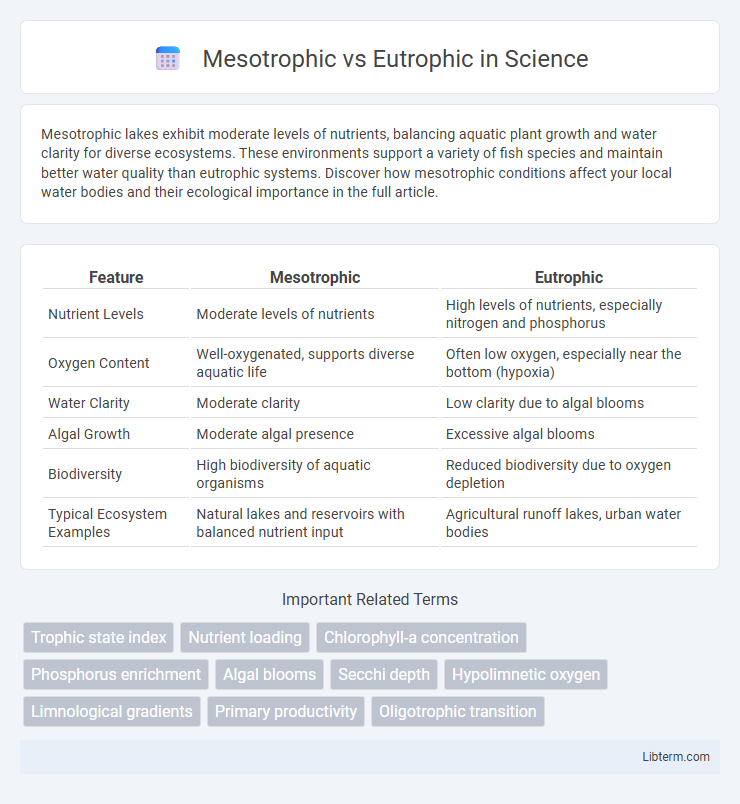Mesotrophic lakes exhibit moderate levels of nutrients, balancing aquatic plant growth and water clarity for diverse ecosystems. These environments support a variety of fish species and maintain better water quality than eutrophic systems. Discover how mesotrophic conditions affect your local water bodies and their ecological importance in the full article.
Table of Comparison
| Feature | Mesotrophic | Eutrophic |
|---|---|---|
| Nutrient Levels | Moderate levels of nutrients | High levels of nutrients, especially nitrogen and phosphorus |
| Oxygen Content | Well-oxygenated, supports diverse aquatic life | Often low oxygen, especially near the bottom (hypoxia) |
| Water Clarity | Moderate clarity | Low clarity due to algal blooms |
| Algal Growth | Moderate algal presence | Excessive algal blooms |
| Biodiversity | High biodiversity of aquatic organisms | Reduced biodiversity due to oxygen depletion |
| Typical Ecosystem Examples | Natural lakes and reservoirs with balanced nutrient input | Agricultural runoff lakes, urban water bodies |
Introduction to Mesotrophic and Eutrophic Waters
Mesotrophic waters contain a moderate level of nutrients, resulting in balanced aquatic ecosystems with healthy plant and animal populations. Eutrophic waters have high nutrient concentrations, particularly nitrogen and phosphorus, leading to excessive algal blooms and oxygen depletion. Understanding the nutrient status of these waters is crucial for managing water quality and ecosystem health.
Defining Mesotrophic and Eutrophic States
Mesotrophic lakes exhibit moderate nutrient levels and balanced productivity, supporting diverse aquatic life without excessive algae growth. Eutrophic lakes contain high nutrient concentrations, particularly nitrogen and phosphorus, leading to dense plant and algal blooms that can deplete oxygen levels. Defining these states primarily involves assessing nutrient availability and biological productivity to determine the ecological balance and water quality.
Key Differences in Nutrient Levels
Mesotrophic lakes exhibit moderate nutrient concentrations, primarily balanced nitrogen and phosphorus levels, supporting diverse aquatic ecosystems without excessive algal growth. Eutrophic lakes contain high nutrient concentrations, particularly phosphorus, leading to dense algal blooms, reduced oxygen levels, and increased organic matter decomposition. These nutrient differences directly impact water clarity, biodiversity, and the overall ecological health of the aquatic environment.
Impacts on Aquatic Ecosystems
Mesotrophic lakes exhibit moderate nutrient levels that support balanced aquatic ecosystems with diverse fish populations and healthy oxygen levels. Eutrophic lakes contain high nutrient concentrations, often causing algal blooms, reduced oxygen, and fish kills, leading to degraded water quality and diminished biodiversity. The shift from mesotrophic to eutrophic conditions can trigger hypoxia and disrupt aquatic food webs, impacting ecosystem stability.
Typical Examples of Mesotrophic Lakes
Mesotrophic lakes, characterized by moderate nutrient levels and balanced oxygen conditions, often host diverse aquatic ecosystems, such as Lake Tahoe in the United States and Lake Zurich in Switzerland. These lakes typically exhibit clear water with intermediate productivity, supporting a mix of aquatic plants, fish species like trout and bass, and balanced algal growth. Unlike eutrophic lakes, which experience excessive nutrient enrichment and frequent algal blooms, mesotrophic lakes maintain ecological stability with moderate nutrient concentrations around 10-30 ug/L of total phosphorus.
Typical Examples of Eutrophic Lakes
Eutrophic lakes, characterized by high nutrient levels and excessive plant growth, are commonly exemplified by Lake Erie in North America, known for its frequent algal blooms and low oxygen zones. Other typical examples include Lake Victoria in Africa, which experiences intense eutrophication due to agricultural runoff and urban waste. These lakes contrast mesotrophic lakes, which have moderate nutrient concentrations and balanced aquatic ecosystems.
Causes of Eutrophication
Eutrophication is primarily caused by excessive nutrient inputs, especially nitrogen and phosphorus, originating from agricultural runoff, wastewater discharge, and industrial effluents. These nutrients stimulate algal blooms and increase organic matter, leading to oxygen depletion and altered aquatic ecosystems. Mesotrophic lakes, with moderate nutrient levels, contrast with eutrophic lakes, which suffer from nutrient over-enrichment and degraded water quality.
Consequences of Eutrophic Conditions
Eutrophic conditions lead to excessive nutrient enrichment, primarily from nitrogen and phosphorus, causing rapid algae and aquatic plant growth. This results in oxygen depletion as decomposing algae consume dissolved oxygen, creating hypoxic or anoxic zones harmful to fish and other aquatic life. Increased algal blooms also reduce water clarity and release toxins, negatively impacting biodiversity, recreational activities, and water quality.
Management and Restoration Strategies
Management and restoration strategies for mesotrophic lakes focus on maintaining balanced nutrient levels to prevent eutrophication by controlling nutrient inputs such as phosphorus and nitrogen through buffer zones and sustainable agricultural practices. Eutrophic lakes require more intensive interventions, including aeration, dredging, and biomanipulation to reduce algal blooms and improve oxygen levels in the water column. Both ecosystems benefit from continuous monitoring and the implementation of adaptive management frameworks to ensure long-term ecological stability and water quality.
Conclusion: Choosing Between Mesotrophic and Eutrophic Waters
Selecting between mesotrophic and eutrophic waters hinges on the balance of nutrient levels and ecosystem health; mesotrophic waters offer moderate nutrient concentrations promoting diverse aquatic life with lower risks of algal blooms. Eutrophic waters contain high nutrient loads that can enhance productivity but often lead to oxygen depletion and harmful algal overgrowth, impacting biodiversity negatively. Effective water management strategies depend on the ecological goals, where mesotrophic conditions typically support stable habitats while eutrophic conditions require intervention to prevent environmental degradation.
Mesotrophic Infographic

 libterm.com
libterm.com